TL;DR
Retaining walls are meant to retain soil, not water; controlled drainage is the difference between a stable wall and a slow-motion failure. If water is gushing through or over your wall, add drainage (French drain, swale, or terrace) to relieve hydrostatic pressure and redirect flow before it reaches the face. At a Glance: - Purpose: Retain soil; let water escape safely - Fixes: 4" perforated drain at base, 12–24" gravel backfill, geotextile fabric, swale/berm upslope - Design targets: 1–2% slope to daylight drains; outlets at ends or to a basin - When to engineer: Over 4 ft high or carrying loads near the top - Quick start: Try your own exterior layout instantly on ReimagineHome.ai: https://www.reimaginehome.ai/?utm_source=blog
12–24 inches of drainage rock is the norm: here’s why it matters for your retaining wall

Proper drainage assemblies relieve hydrostatic pressure to keep retaining walls durable and secure.
Landscaping ideas that survive real storms start with water. In hardscaping design, a retaining wall should be paired with drainage: a 4" perforated pipe set at the base, wrapped in fabric, surrounded by 12–24" of clean gravel, and separated from native soil with geotextile. That assembly relieves hydrostatic pressure—the number one cause of wall failure—so the wall can do its job: hold soil. In heavy rain, sheet flow will still race down a slope. Without an upslope diversion swale or berm, that water often leaps the cap or jets through joints. The fix is not to make a dam; it’s to route water away before it builds pressure. This is where modern yard design meets practical hardscaping: French drains, graded swales, and, on steeper sites, terrace levels that slow water and create outdoor living spaces. Alt: “Retaining wall with a 12–24 inch gravel backfill zone, perforated base drain, and geotextile separation, visualized in ReimagineHome.ai.” Caption: “Drainage-first hardscaping keeps walls stable while improving front yard design and curb appeal.”
2 inches per hour overwhelms most yard drains: why landscaping and hardscaping are changing
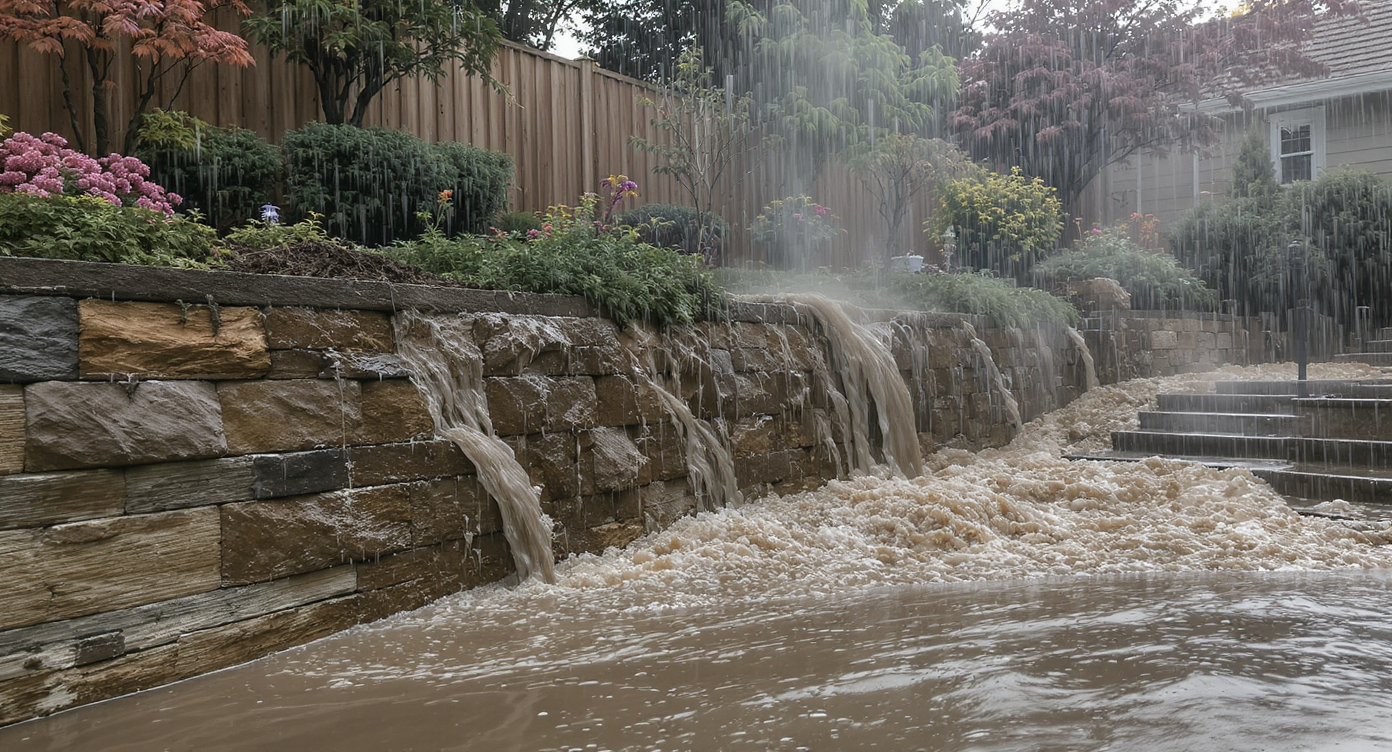
Cloudburst storms overwhelm typical drains, emphasizing the need for improved water management features.
Most residential drainage systems aren’t built for cloudburst events. A storm dumping around 2 inches per hour will outrun lawn infiltration and overwhelm minimal backfill, which is why water sometimes pours over the cap. Good hardscaping design anticipates both everyday seepage and those peak flows. What to change first: create a place for the water to go. A shallow swale set 3–10 feet upslope with a 1–2% pitch can intercept most surface runoff and carry it toward side yards or a catch basin. Pair that with a base drain behind the wall: a 4" perforated pipe bedded in clean gravel, sloped 1% to daylight at the ends. Keep fines out of the system with a continuous geotextile “burrito.” If your wall is over 4 feet, near a driveway, or supporting surcharge loads (like a patio), bring in an engineer and follow the block manufacturer’s specs for geogrid, step-back, and setbacks. For freeze–thaw regions, controlled drainage prevents frost jacking that nudges caps forward season after season.
Anecdote
A homeowner on a steep lot thought the wall was failing when rain turned it into a waterfall. The fix wasn’t heroic—just a grassed swale 8 feet upslope, a base drain daylighted at the side yard, and a narrow gravel strip at the cap. Next storm, the patio stayed quiet.
4 drainage‑first retaining wall trends shaping modern yard design

Modern yard designs integrate terraces and French drains to balance beauty and drainage performance.
Drainage-first doesn’t mean dull. These hardscaping ideas elevate both performance and outdoor living. - 4" perforated pipe at the base: This is the workhorse. Place it just behind the first course, pitch 1% minimum, and daylight to the ends or a basin. Tie in downspouts only if the system is sized for it. - 12–24" clean gravel backfill: The open-graded stone becomes a vertical French drain, letting water drop fast instead of pressing on the wall. Cap the top with 3–4" of soil for turf—better yet, plant a strip of native grasses. - 1–2% swale upslope: A grassed or stone-lined swale moves stormwater away before it finds your cap. In tight lots, a linear trench drain behind the wall can perform the same job and feed the pipe. - Two-tier terrace levels: Breaking a steep grade into two 18–30" rises creates usable outdoor rooms—think stone patio or seating pad—while cutting water velocity. It’s a backyard makeover and a hydraulic fix. Alt: “Stone patio atop a terraced retaining wall with a grassed swale intercepting runoff, rendered in ReimagineHome.ai.” Caption: “Terraces slow water and add outdoor living square footage.” Explore step-by-step layouts: https://www.reimaginehome.ai/blogs/terraced-yard-ideas?utm_source=blog
5 steps: use ReimagineHome.ai to test swales, French drains, and terraces before you dig
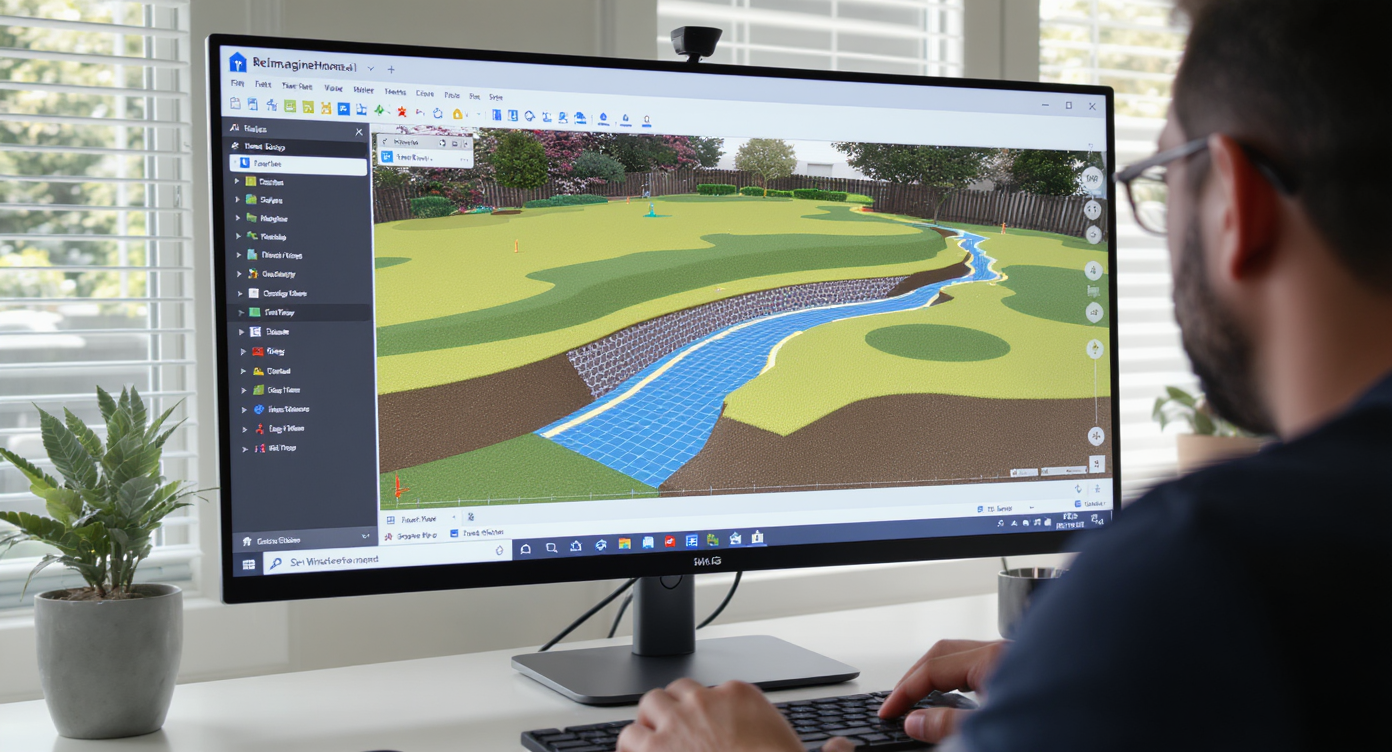
Use ReimagineHome.ai to test drainage solutions digitally before breaking ground.
Model once, decide with confidence. Here’s how to use ReimagineHome.ai for hardscaping design and drainage visualization. - Upload a photo of your yard and mark the slope edge; choose “hardscaping design” to add a retaining wall, steps, and a stone patio. - Toggle “drainage overlay” to sketch a 1–2% swale and see where water would flow in plan view. - Add a 4" base drain icon, set outlet left or right, and preview daylight locations. Try alt materials like permeable pavers. - Test terrace levels by splitting a single tall wall into two lower walls with a planted shelf or seating pad between. - Compare before/after curb appeal, then export a plan to discuss with your contractor. Learn more with our drainage guide: https://www.reimaginehome.ai/blogs/retaining-wall-drainage-design?utm_source=blog and our swale vs. French drain explainer: https://www.reimaginehome.ai/blogs/french-drain-vs-swale?utm_source=blog. Early CTA: Try your own exterior layout instantly on ReimagineHome.ai: https://www.reimaginehome.ai/?utm_source=blog
3 real projects that stopped ‘weeping wall’ waterfalls
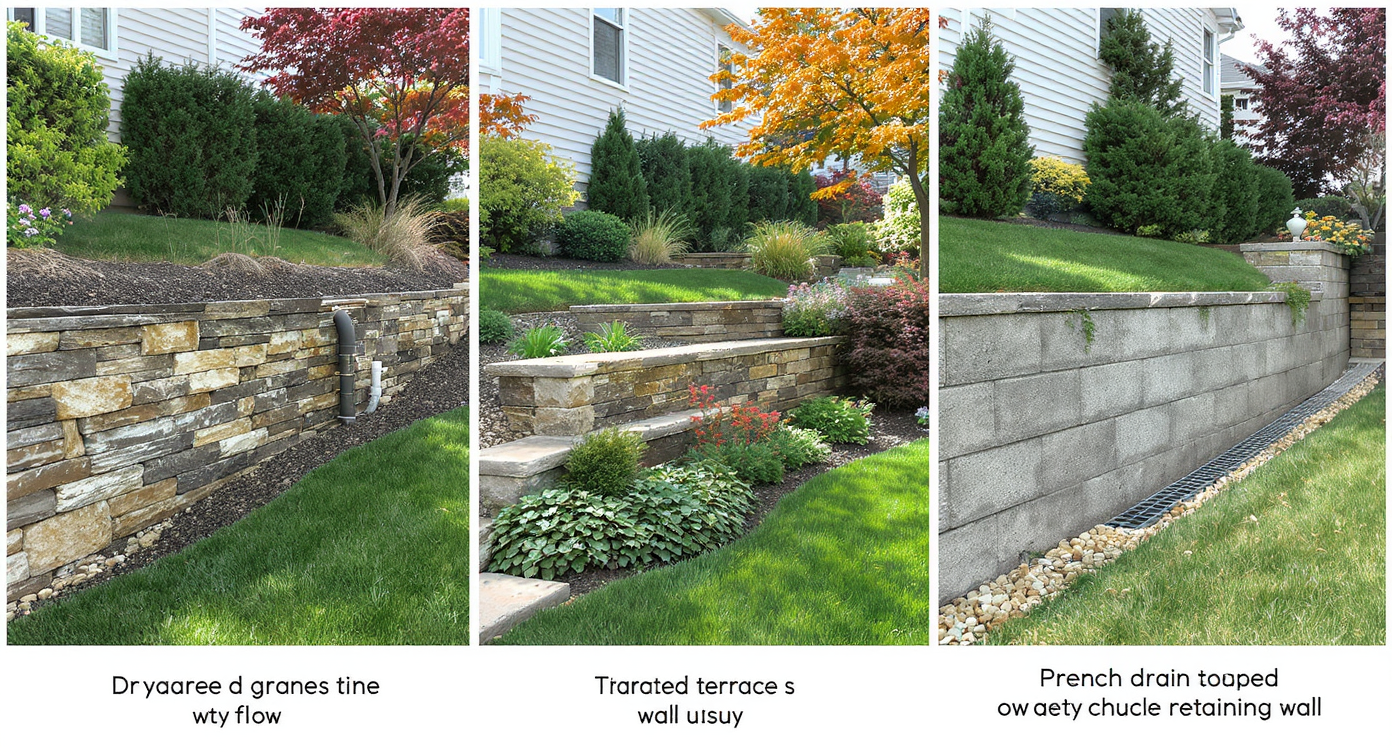
Successful projects demonstrate practical fixes to prevent retaining wall water seepage and failure.
- Nashville, TN: A new construction home saw water “spouts” through a dry-stacked wall during cloudbursts. A shallow grassed swale 6 feet upslope plus a 4" drain at the base cut peak flow by feel—and ended the waterfalls. - Denver, CO: Freeze–thaw pushed caps forward each spring. Rebuild wasn’t required; adding 18" of clean gravel backfill with geotextile, plus weep outlets at the ends, relieved pressure and stopped seasonal creep. - Los Angeles, CA: A narrow side yard became a stone-lined walkway and infiltration trench. The wall stayed under 4 feet to avoid engineering, while a perforated pipe pitched 1% to the front curb handled downpours without surfacing.
Visualization Scenario
Upload a photo of your sloped backyard to ReimagineHome.ai. Add a dry-stacked retaining wall, then draw a 1–2% swale above it and drop in a 4" perforated pipe at the base. Toggle terrace mode to split the grade and place a stone patio on the upper level; compare runoff paths and seating layouts in seconds.
8 quick answers about retaining walls, French drains, and weep holes
- Is water supposed to come through a retaining wall? Yes. Retaining walls retain soil; controlled seepage relieves hydrostatic pressure. Aim for water to exit at the base via a 4" pipe or through designed weep points, not random joints. - How much gravel should go behind a wall? Plan 12–24 inches of clean, open-graded gravel directly behind the wall, wrapped with geotextile to keep fines out. - Do I need a French drain or a swale? Often both. The French drain handles subsurface water; a 1–2% swale intercepts fast surface runoff before it reaches the cap. - What slope should the drain pipe have? Target about 1% (roughly 1/8 inch per foot) to daylight at the ends or into a basin. - When do I need an engineered wall? Many jurisdictions require engineering and permits for walls over 4 feet or those bearing nearby loads (driveways, patios, fences). - How do freeze–thaw cycles affect walls? Water expands when frozen. Without drainage, ice can jack caps forward over years; drainage prevents that. - Who fixes drainage on a new build? Check your contract and local codes. Builders often warrant workmanship for a period; if the wall lacks basic drainage, document and request correction. - Can ReimagineHome.ai simulate drainage options? Yes. You can sketch swales, place outlets, and compare terrace layouts alongside stone patio or walkway design to see how it all connects.
1 tool, many outcomes: visualize curb appeal and drainage together
One platform can help you weigh all the trade-offs—materials, drainage, planting, and outdoor lighting design—before you plant or pour. ReimagineHome.ai lets you test modern landscaping ideas for small front yards, terrace levels for steep backyards, and walkway ideas that double as drains, so your curb appeal isn’t washed out by the next storm. Reflective CTA: See your wall, swale, and patio options side-by-side in minutes: https://www.reimaginehome.ai/?utm_source=blog
.svg)

.svg)


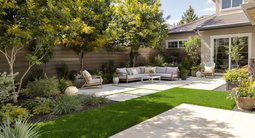
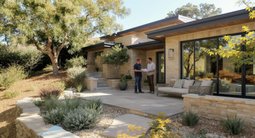


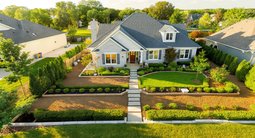
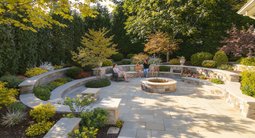


.png)